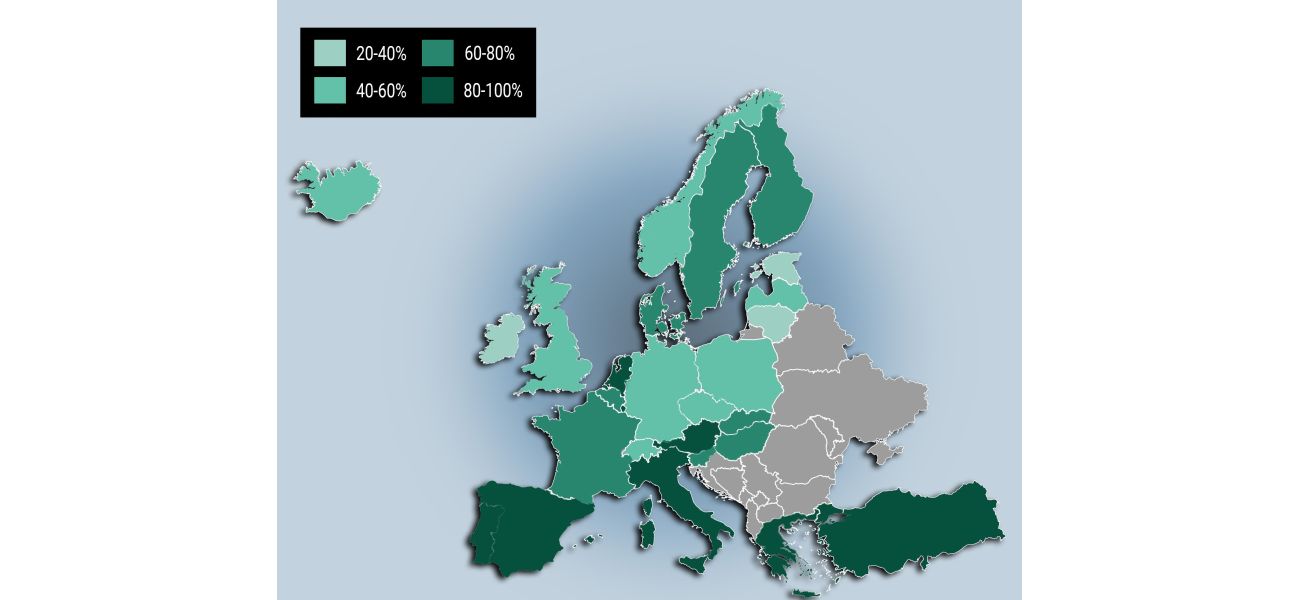Graph displays UK pension rankings in Europe post-Autumn Budget.
Retired individuals in Portugal receive almost the same amount as the average worker when they collect their pension.
November 1st 2024.

Our map showcases a comparison between the amount an average person would receive as a pension versus their working salary in various European countries. Upon examining this data, it is clear that the UK is lagging behind many of its European counterparts in terms of the generosity of our pensions. This can be seen when comparing the amount of pension received to the salaries earned during their working years.
According to recent statistics from 2022, the average Briton receives only 54.4% of their working salary once they begin drawing their pension. In contrast, pensioners in Portugal receive nearly 100% of their previous earnings, as reported by the OECD. The EU average falls at 68.1%, highlighting the discrepancy between the UK and other European countries.
These figures have come to light following the announcement of the first Labour Budget in 14 years by Chancellor Rachel Reeves. The budget includes an additional £40 billion in taxes, with the confirmation that the state pension will rise by 4.1% in the upcoming financial year. This means that over 12 million pensioners will receive an extra £470 annually.
It is worth noting that the government has previously justified these increases by claiming that they would cover the expenses lost by most pensioners due to the controversial cuts to the Winter Fuel Allowance. Additionally, as part of yesterday's Budget, the Treasury has announced that unused pension funds will now be included in a person's estate for Inheritance Tax purposes, in an effort to boost revenues from this source.
Further examination of the OECD's statistics reveals that the UK's pension "replacement rate," meaning the percentage of an average working salary that a person can expect to receive as a pension, is comparable to that of Norway and Germany. On the other end of the spectrum, countries like Turkey, the Netherlands, and Greece boast a replacement rate of 90% or higher.
Among the European countries with the lowest pension replacement rates are Lithuania, Estonia, and Ireland. Currently, British pensioners receive either the Old State Pension or the New State Pension, depending on when they reached the age to begin drawing their pension. The Old State Pension is a two-tier system, with a flat rate of £169.50, supplemented by an additional earnings-related payment. Meanwhile, the New State Pension consists of a single-tier flat-rate allowance, with a maximum value of £221.40 per person, per week. Both of these figures are subject to an annual increase of whichever is highest among 2.5%, inflation, or earnings growth, through the "triple lock" system.
According to recent statistics from 2022, the average Briton receives only 54.4% of their working salary once they begin drawing their pension. In contrast, pensioners in Portugal receive nearly 100% of their previous earnings, as reported by the OECD. The EU average falls at 68.1%, highlighting the discrepancy between the UK and other European countries.
These figures have come to light following the announcement of the first Labour Budget in 14 years by Chancellor Rachel Reeves. The budget includes an additional £40 billion in taxes, with the confirmation that the state pension will rise by 4.1% in the upcoming financial year. This means that over 12 million pensioners will receive an extra £470 annually.
It is worth noting that the government has previously justified these increases by claiming that they would cover the expenses lost by most pensioners due to the controversial cuts to the Winter Fuel Allowance. Additionally, as part of yesterday's Budget, the Treasury has announced that unused pension funds will now be included in a person's estate for Inheritance Tax purposes, in an effort to boost revenues from this source.
Further examination of the OECD's statistics reveals that the UK's pension "replacement rate," meaning the percentage of an average working salary that a person can expect to receive as a pension, is comparable to that of Norway and Germany. On the other end of the spectrum, countries like Turkey, the Netherlands, and Greece boast a replacement rate of 90% or higher.
Among the European countries with the lowest pension replacement rates are Lithuania, Estonia, and Ireland. Currently, British pensioners receive either the Old State Pension or the New State Pension, depending on when they reached the age to begin drawing their pension. The Old State Pension is a two-tier system, with a flat rate of £169.50, supplemented by an additional earnings-related payment. Meanwhile, the New State Pension consists of a single-tier flat-rate allowance, with a maximum value of £221.40 per person, per week. Both of these figures are subject to an annual increase of whichever is highest among 2.5%, inflation, or earnings growth, through the "triple lock" system.
[This article has been trending online recently and has been generated with AI. Your feed is customized.]
[Generative AI is experimental.]
0
0
Submit Comment





